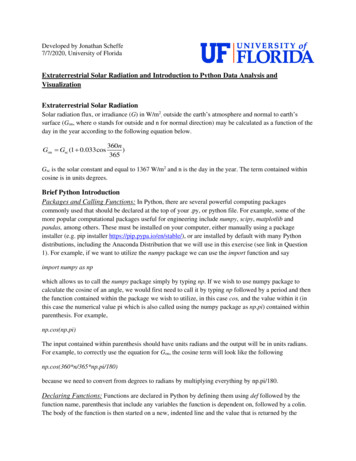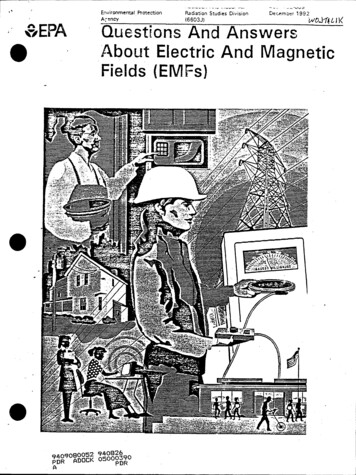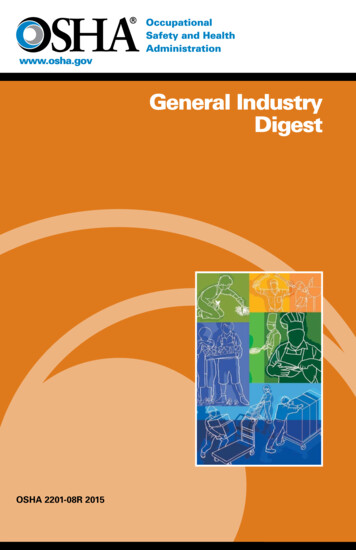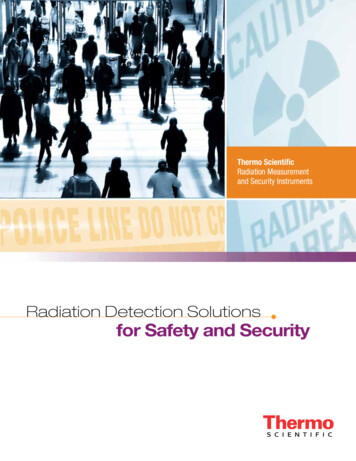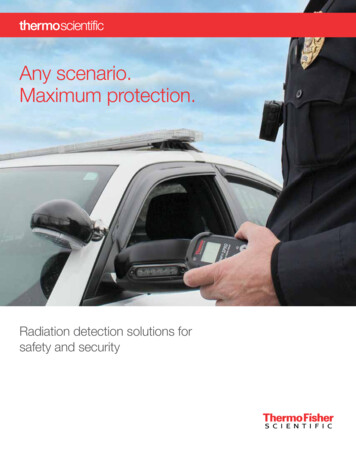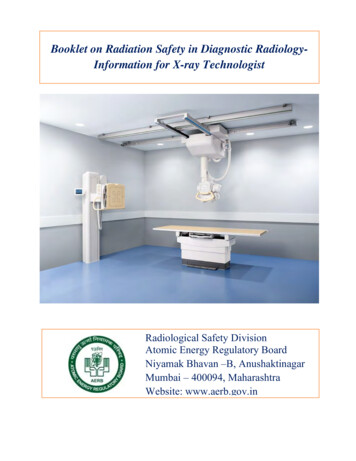
Transcription
Booklet on Radiation Safety in Diagnostic RadiologyInformation for X-ray TechnologistRadiological Safety DivisionAtomic Energy Regulatory BoardNiyamak Bhavan –B, AnushaktinagarMumbai – 400094, MaharashtraWebsite: www.aerb.gov.in
PrefaceSince the discovery of X-rays in 1895, X-ray examinations have become anintegral part of medical diagnostic radiology practice. Society is derivingimmense benefits from the use of X-rays, by detection of a variety ofdiseases, bone fractures and deformations. Though the use of X-rays hasgiven tremendous benefits to the society, excess radiation dose of X-rays isharmful to human beings. With increase in the medical applications ofX-rays, concern over radiation safety has also grown.The aim of this booklet is to provide basic information as a quick referencefor X-ray Technologist(s) pertaining to usage of diagnostic X-rays andradiation safety in various modalities of X-ray imaging.This booklet gives a brief overview of radiation, types of radiation, sourcesof ionisation radiation, diagnostic X-ray equipment, various modalities of Xray imaging and the precautions that need to be taken by Xray Technologist(s) during operation of these modalities of X-rayequipment.We hope that this booklet will help in achieving radiation safety indiagnostic X-ray imaging.1
nTypes of RadiationSources of Ionising RadiationBasic Principles of Radiation ProtectionHealth Effects of Ionising RadiationAtomic Energy Regulatory Board (AERB)Responsibility of LicenseeDiagnostic X-ray EquipmentDifferent Modalities of X-ray ImagingBasic Factors of Radiation Hazard ControlRadiation MonitoringRadiation Safety during operation of X-ray equipmentRegulatory Requirements for Diagnostic X-ray FacilitiesQuestions and AnswersImportant: Do not forget to read the answers of frequently askedquestions by X-ray Technologist(s)To have a quick understanding on radiation safety aspects, readText written in such boxes are very important from radiationsafety view point2
1. Radiation Radiation is the energy that travels in the form of waves or particles. Radiation includes electromagnetic radiation, such as radio waves, microwaves,visible light, X-rays and gamma rays (γ). Radiation is present everywhere in the universe.2. Types of RadiationThere are two types of radiation: Ionising Radiation Non-Ionising RadiationIonising Radiation Radiation that has sufficient energy to eject electrons from atoms of matter orbody tissues through which it traverses is called ionising radiation.Examples: Medical and dental radiography, computed tomography (CT),nuclear medicine and fluoroscopy procedures are examples of diagnosticexaminations that use ionising radiation.Non-Ionising Radiation Non-ionising radiation is the radiation that has enough energy to vibrate atomsbut does not have enough energy to remove electrons from atoms of matter orbody tissues.Examples: Radio waves and microwaves.Ultrasound and magnetic resonance imaging (MRI) are examples of diagnosticexaminations that use non-ionising radiation.1. Electromagnetic SpectrumX-ray units are regulated by AERB while Ultrasound and MRI unitsare not regulated by AERB.3
3. Sources of Ionising Radiation:Sources of ionising radiation are of two types: Natural sources of ionising radiation Manmade sources of ionising radiationNatural sources of ionising radiation Ionising radiation is present everywhere in nature in varying amounts at differentlocations and it is a part of our daily life. We all are exposed to natural background radiation every day in our lives. Thiscomes from the ground and building materials around us, the air we breathe, thefood we eat and even from outer space (cosmic rays). Depending upon the location where one individual lives, each individual isexposed to 1 to 3 mSv every year, with global average of 2.4 mSv from thenatural sources of ionising radiation.2. Natural Sources of RadiationNatural radiation sources of ionisation radiation are not amenableto control and therefore excluded from regulatory control.4
Manmade sources of ionising radiation The use of ionising radiation in medicine is the largest source of manmaderadiation today. The most well-known application is diagnostic X-ray equipment, which uses Xrays for examining chest, teeth, broken bones etc.3. Medical Application of Radiation (Diagnostic X-rays) Another application of manmade source of ionising radiation is nuclearmedicine, in which small amount of radioactive material (isotope) is injectedinto the veins of a patient, which concentrates in a particular organ of interest,for example in the skeleton for a bone scan. The radioactive material emitsgamma rays, which are a type of radiation that behave like X-rays. A specialcamera detects the gamma rays coming out from the body of the patient andbuilds up an image of what is happening inside the body of the patient. Other manmade source of ionising radiation includes industrial radiography andnucleonic gauging applications which are used in various industries such asconstruction, civil engineering and oil well-logging applications.5
4. Basic Principle of Radiation Protection:JustificationIt should be ensured that a diagnostic X-ray examination on a patient will domore good than harm. Medical practitioner and radiology department should ensure that when radiation(X-rays) is used, the benefits from making the right diagnosis and consequentlygiving the right treatment to the patient, is always greater than any small riskinvolved. Justification of application of X-rays in medical diagnosis by clinician.Optimization It is important to deliver the smallest amount of radiation (X-rays) needed toobtain images for desired purposes. In other words, application of X-rays duringdiagnostic examinations are so optimized by proper selection of operatingparameters (kV, mA, X-ray ON time and field size) that it provides acceptableimage quality with minimum patient dose. It should also be ensured that during diagnostic X-ray examinations, radiationdose to the operator(s) are kept as low as reasonably achievable (ALARA).Optimization of medical exposure by operator– minimum dose fordesired Image.Dose Limits Radiation dose to any individual (radiation worker(s) or member of public) fromradiation source (X-ray equipment) should not exceed the prescribed DoseLimits. Dose Limits are not applied to patients undergoing X-ray examinations as theyare benefitted with right diagnosis.AERB has prescribed dose limit for occupational workers such asX-ray Technologists and medical practitioner(s) as 20 mSv in ayear averaged over five consecutive years and dose limit formembers of public as 1 mSv in a year.6
5. Health Effects of Ionising Radiation Every individual receives average 2 mSv radiation from natural sources ofionising radiation whereas radiation received by a patient in diagnostic X-rayexaminations varies typically from 0.2 to 1.8 mSv. In such low radiation levels,no health effects are detected. As per dose records of radiation workers ofdiagnostic radiology practice in India, majority of persons working with X-rayequipment receive radiation doses less than 1mSv in a year. It may be noted that radiation effects can be seen in human being at cellular levelonly when the whole body radiation received by an individual exceeds 100 mSv.The other noticeable health effects can be seen above a dose of 1000 mSv. However, the radiation protection community assumes that any amount ofradiation may induce some effects which are not detectable at low level ofradiation. Therefore, it is appropriate to follow safety precautions to minimizethe effects of radiation on human health as much as possible.X-ray equipment installed in a room with proper shielding and use ofprotection devices (protective barrier or lead apron) by X-rayTechnologist(s) during operation of X-ray equipment ensure thatradiation dose received by X-ray Technologist(s) is as lowas reasonable achievable (ALARA).6. Atomic Energy Regulatory Board (AERB) AERB regulates all facilities using radiation sources including medicaldiagnostic X-ray equipment (e.g. CT scans, General X-rays, Dental X-rays etc.)used in hospitals/clinics in the country. AERB regulates radiation facilities such as X-ray facilities by issuing licence foroperation of their X-ray equipment and approving design of diagnostic X-rayequipment.The Mission of AERB is to ensure that the use of ionising radiationand nuclear energy in India does not cause undue risk to the healthof people and the environment.7
7. Responsibility of LicenseeAlthough radiation dose received by X-ray Technologist(s) and medicalpractitioner(s) in diagnostic radiology practice is very low, however, it is theresponsibility of theowner (employer) of the facility for providingpersonnel monitoring devices (TLD badges) to radiation workers such as X-rayTechnologists and medical practitioner(s) and to ensure that dose received byradiation worker(s) are as low as reasonable achievable (ALARA).It is the prime responsibility of the owner (employer) of radiation facilitysuch as X-ray facility to ensure radiation safety of radiation workers andmembers of public on account of operation of his X-ray equipment.8. Diagnostic X-ray Equipment Diagnostic X-ray equipment is an equipment in which X-rays are produced whenaccelerated electrons hit the target material (generally made up of tungsten) andconvert their kinetic energies into X-rays.Typical diagnostic X-ray equipment includes a generator (tube voltage supply),X-ray tube, patient positioning table and screen-film system.4. Schematic Diagram of X-ray Equipment9. Different Modalities of X-ray ImagingA8RadiographyIn radiography, a short duration pulse of X-rays is emitted by the X-ray tube, alarge fraction of X-rays interacts in the patient body and some of the X-rays passthrough the patient body (transmitted X-rays) and reach the detector.These transmitted X-rays form the radiographic image of a patient on thefilm/detector.
Generally Radiography equipment is used for chest, abdomen and extremities(hands & feet) examinations.X-ray TubeExamination TableChest Stand5. Radiography (fixed) X-ray EquipmentB.Fluoroscopy:Fluoroscopy is an imaging modality that uses X-rays to obtain real-time movingimages of the internal organs of a patient.Fluoroscopy is performed by two types of equipment:(i)9C-Arm EquipmentIt is a C-shape equipment in which X-ray tube is at one end and an imageintensifier/ digital detector at other end of equipment.It shows continuous images of a body part on the TV monitor, much like anX-ray movie.Generally, C-arm is used in orthopedic and urology department.
6. C-Arm X-ray Equipment(ii)Interventional Radiology EquipmentInterventional radiology (IR) equipment uses high capacity C-armequipment for fluoroscopically guided interventional procedures.Generally, IR equipment is used in cardiac studies.7. Interventional Radiology X-ray Equipment10
C. MammographyIt is especially designed X-ray equipment used for obtaining radiographic imagesof breast.It is employed both for screening as well as diagnosis of breast ailments.8. Mammography X-ray EquipmentD. Bone Mineral Densitometer (BMD):It is also called dual-energy X-ray absorptiometry (DEXA) system and uses Xrays to measures the strength of bones.9. Bone Mineral Densitometer X-ray Equipment11
E. Computed Tomography (CT):Computed tomography (CT) scanner is a particular type of X-ray equipment inwhich X-ray tube produces a beam in the shape of a fan and moves around thepatient in a circle.The X-rays are detected electronically and a computer uses the information toreconstruct an image of the region of the body exposed.10. Computed Tomography X-ray Equipment10. Basic Factors of Radiation Hazard ControlTime, Distance and Shielding are basic factors for controlling radiation hazardfrom diagnostic X-ray equipment.Time: The amount of radiation dose an individual receives, will depend on howlong the individual stays in the radiation (X-ray) field. Radiation dosefrom X-ray equipment is directly proportional to time.Safe, when X-rays are OFF.Lesser the time of X-rays ON, lesser will be the radiation received by anindividual.12
Distance: The exposure rate at any point from an X-ray equipment at a specifieddistance varies inversely as the square of the distance.11. Inverse Square LawX-ray intensity decreases sharply as a person moves farther awayfrom the X-ray unit.Shielding: The exposure rate decreases exponentially with the increasing thicknessof shielding material placed between the X-ray beam and the point ofinterest (e.g. location of X-ray Technologist).Generally lead and brick are used as shielding material in X-rayfacilities.12. Penetration of X-raysThe thicker the shielding material placed between the person and X-rayUnit, the lesser the radiation to which a person will be exposed.13
11. Radiation Monitoring TLD badge is a radiation dose measuring device. TLD badge enables us to know whether we are working within the safe doselimit prescribed by AERB. TLD badges should always be used with cassettes as bare TLD card provideswrong information of individual’s dose. TLD badges should always be stored in radiation free area (outside the X-rayinstallation room). TLD cards should be changed in every monitoring period (e.g. quarterlymonitoring period) and used TLD cards should be returned back to accreditedlaboratory for dose assessment.13. TLD badges loaded in cassettesTLD withcassetteTLD withoutcassette14 Use TLD Badge with CassetteTLD badges should be used by radiation workers such as X-rayTechnologists and medical practitioner(s) during operation of X-rayequipment or working in the proximity of diagnostic X-rayequipment.14
12. Radiation Safety during operation of X-ray equipment:A. Radiography (Fixed) Installation:Always wear TLD badge at chest level.Always stand behind the protective barrier while operating X-rayequipment. It protects X-ray Technologist(s) from scattered radiationemitted from patient during X-ray imaging.Avoid self-holding of the patient for X-ray imaging. If needed, ask thepatient’s relative to assist the patient by providing him a lead apron.Use collimator (diaphragm) to limit the X-ray field size to the area ofinterest.Ensure X-ray room door(s) is closed during X-ray imaging.15. Safe Operation in Fixed X-ray Installation15
B. Radiography (Mobile):Always wear TLD badge at chest level below lead apron.Operate the mobile X-ray equipment by extending the control cable.Use lead apron during X-ray imaging.16 Safe Operation of Radiography (Mobile) X-ray Equipment16
C. Computed Tomography (CT) Installation:Always work from the control room.Always wear TLD badge at chest level.Avoid self-holding of the patient during CT scan. If needed, ask thepatient’s relative to assist the patient by providing him a lead apron.Ensure CT room door(s) is closed during CT imaging.17. Correct way of wearing TLD Badge17
18. Operation of CT equipment from Control ConsoleD. Interventional Radiology Installation:Always wear TLD badge at chest level below lead apron.Use lead apron during X-ray based interventional radiologicalprocedures.Use ceiling suspended screens and couch hanging lead rubbers flapsattached with IR equipment during IR procedures.Position the X-ray tube under couch and Image Intensifier/detectorover couch during IR procedures.18
19. Wear TLD badge below lead apron20. Safe operation and use of protective devices in Interventional Radiology Installation19
E. Mammography Installation:Always wear TLD badge at chest level.Always stand behind the protective barrier while operation.21. Operate Mammography X-ray Equipment behind the protective barrier20
13. Regulatory Requirements for Diagnostic X-ray Facilities: It is mandatory for all users/owners of diagnostic X-ray facilities to obtainLicence for operation of their diagnostic X-ray equipment from AERB under theprovision of Atomic Energy (Radiation Protection) Rules 2004. Licence for operation of diagnostic X-ray equipment can be obtained through elicensing of radiation applications (e-LORA) system available at AERB website(www.aerb.gov.in) by following ways:a.b.c.d.Institute Registration to get user ID and password for submission ofapplications in e-LORA system.Apply for Procurement Permission for purchase or import of X-rayequipment.Submission of details of X-ray Technologist(s), medical practitioner(s)and protective devices.Apply for licence for operation.More information for obtaining Licence for operation of diagnostic X-rayequipment can be downloaded from AERB’s website through the following medicine/diagnostic-radiology22. Warning Placard for display outside the X-ray Installation.Display copy of AERB Licence along with warning placard outside X-rayInstallation.21
14. Questions and Answers:Q.1 Who has the prime responsbility for ensuring radiation safety in X-ray facility?Ans. Employer of the institution has the prime responsibility for ensuring radiationsafety in X-ray facility.Q.2 How long X-ray exists after the exposure is over?Ans. When the exposure is over, the X-ray unit does not emit X-ray radiation. Itmeans that when X-ray is OFF, there is no radiation safety concern. It is similarto switching-off an electric bulb where no light exists after it is switched-off.Q.3Ans.List basic factors for radiation hazard control from an X-ray equipment?It should be noted that when X-rays are ON, there is radiation safety concern.Therefore, during X-ray ON condition, spend less ‘Time’ in X-ray room, keepaway from X-ray equipment (maintaining Distance) and stand behind theprotective barrier while working in X-ray room (Shielding-use of protectiondevice).Q.4List safety procedures to be followed by an X-ray Technologist while operatingfixed radiography X-ray facility?Ans. X-ray Technologist should follow the following procedures:a) Always stand behind the protective barrier while operating X-rayequipment;b) Always wear TLD badge at chest level;c) Ensure X-ray room door(s) is closed during X-ray imaging;d) Use collimator (diaphragm) to limit the X-ray field size to the area ofinterest ande) Avoid self-holding of the patient during X-ray imaging. If needed, askthe patient’s relative to assist the patient by providing him a lead apron.Q.5 Where to store TLD badges after the routine work?Ans. In radiation free area (outside the X-ray room). TLD badges should not be storedin the control panel/control console room of X-ray equipment.Q.6 Whether TLD badge provide radiation safety to X-ray Technologist?Ans. NO, TLD badge only measures the radiation dose received by an X-rayTechnologist.22
Q.7What are the annual radiation dose limit for an X-ray Technologist and membersof public?Ans. Annual dose limit for radiation worker such as X-ray Technologist is 20 mSv in ayear averaged over five consecutive years and annual dose limit for members ofpublic is 1 mSv in a year.Q.8How many X-ray exposures are permitted to be performed in a day as well as in amonth by an X-ray Technologist?Ans. AERB has NOT prescribed the maximum / mandatory working hours in a day /week / month and / or maximum no. of exposures permitted to be performed by aradiation worker such as X-ray Technologist in a day / week / month in a radiationfacility (X-ray facility). However, the employer and X-ray Technologist(s) shouldensure that the radiation dose received due to working with X-ray equipment shallnot exceed the occupational dose limits specified by AERB. Radiation worker (Xray Technologist) can find his radiation dose from TLD Dose reports.Q.9Is there any ‘risk leave’ for X-ray Technologist(s) in the hospital prescribed byAERB? Whether radiation ‘risk allowances’ should be given to X-rayTechnologist(s)?Ans. There is NO risk leave and/or risk allowance prescribed by AERB for radiationworkers (X-ray Technologists).Q.10 How safe the radiation worker(s) are in diagnostic radiology practice in India?Ans. As per dose records of radiation workers of diagnostic radiology practice in India,annual average dose to a radiation worker(s) of diagnostic radiology practice inIndia is about 0.64 mSv which is below the dose limit of members of public. Thislow radiation dose to radiation worker(s) in diagnostic radiology practice can beattributed to the following factors: (1) improved engineering safety in the X-rayequipment which is ensured by AERB through issuance of type approval of everynew model of X-ray equipment (2) use of protection devices by operators viz.protective barrier or protective lead apron during X-ray imaging and (3) improvedawareness on radiation safety.-------XXX--------23
Interventional radiology (IR) equipment uses high capacity C-arm equipment for fluoroscopically guided interventional procedures. Generally, IR equipment is used in cardiac studies. 7.Interventio
